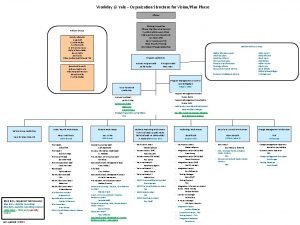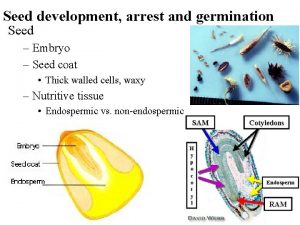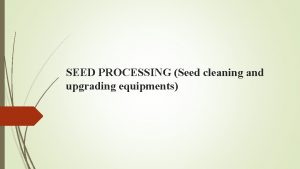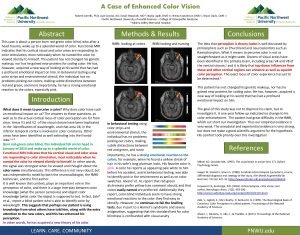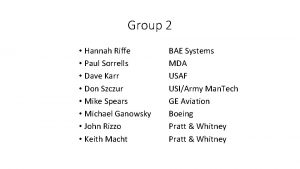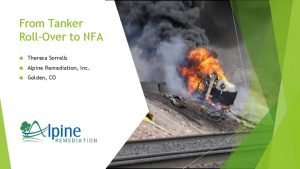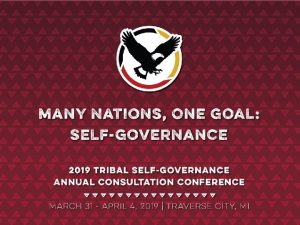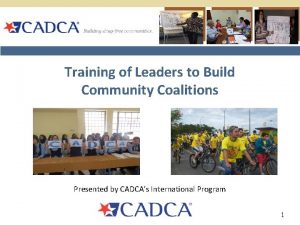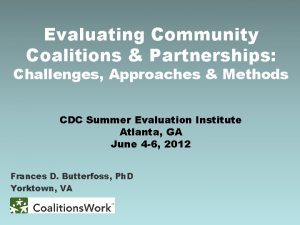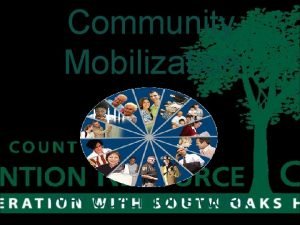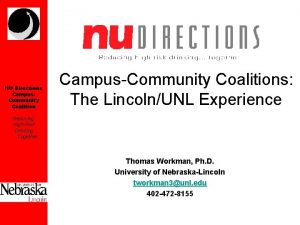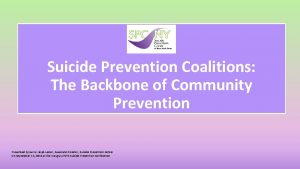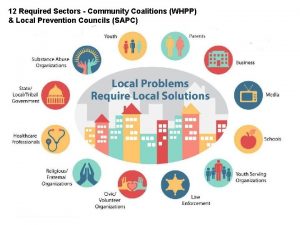SEED Coalitions for Community Growth Shauna Sorrells SEED






















- Slides: 22

SEED: Coalitions for Community Growth Shauna Sorrells SEED Director Housing and Urban Development’ STEM, Energy, and Economic Development Overview 11 Erin Twamley SEED Project Manager Department of Energy

What is SEED? : STEM, Energy and Economic Development • Place-based initiative building local coalitions to: • Increase energy-literacy • Facilitate STEM opportunities • Promote job-driven skills • SEED Coalition’s are committed to preparing residents of public housing localities for current and future in-demand STEM & Energy jobs • 6 Pilot Cities • Denver, CO • Washington, D. C. • Tampa, FL • Cleveland, OH • San Antonio, TX 2 • Austin, TX SEED Federal Partners SEED National Partners

The Three Pillars of SEED Training and Technical Assistance PILLAR I: Energy Literacy Promote energy literacy and conservation among residents; PILLAR II: STEM Educational Opportunities Create STEM-based learning opportunities for residents; PILLAR III: Job-Driven Skills Develop meaningful job pathways by leveraging federal, state, and local resources for training and employment in STEMoriented careers. Increase Economic Opportunity for Public Housing Residents and Surrounding Community 3

Why SEED: Coalitions for Community Growth • • Creates a Common agenda among local partners in the coalition Promotes local empowerment through public-private partnerships Uses existing federal resources to increase impact in Public Housing Highlights the importance of energy efficiency and savings to residents Facilitates increased STEM training opportunities for residents Prepares current and future workers for in-demand STEM jobs Adds to efforts needed to reach national climate change objectives Improves efforts to reach populations historically underrepresented in this country's STEM pipeline: women, minorities and students from economically distressed communities STEM, Energy, and Economic Development 4

Goals for SEED Training and Technical Assistance National Goal: 10, 000 hours of STEM training (e. g. , classes, mentoring, after-school programs, certificate completions and employment) Should match what we say for CGI in the application? Local Goals: • Each pilot coalition determines own goals • Metrics guidance are provided • Program plan helps to strategize and implement 5

Current Federal SEED Partners • • • 6 Energy Literacy information and resources Better Buildings Challenge for multi-family housing Energy career information Promotes efforts to increase women and underserved communities in energy careers • • Provides credentialing • information Provides info on STEM Learning Ecosystems Connects with career and • technical education programs Connects with adult education providers Supports facilitators with professional development resources Public Housing Spaces Low-income Residents Support services through grants (e. g. Choice, ROSS) Mission of using housing as a platform to improve quality of life (e. g. section 3) Provides capacity building resources to SEED Coalitions (e. g. Ameri. Corps and VISTA members) Supports STEM volunteer efforts in cities

Current National Partners • • • 7 Commits to disseminate Energy Literacy materials to at least 100 Corps and 27, 000 Corpsmembers Commits to disseminate HUD STEM Education materials to at least 100 Corps and 27, 000 Corpsmembers Commits to recruit at least 100 PHA youth • Provide membership in K-12 Alliance for PHAs Provide technical assistance to PHAs for applying to Aspire. IT Program. • • Commits to help build the STEM mentoring movement Provides access for PHAs to STEM mentor matching portal Commits up to 50% of the service time of a full-time VISTA staff member Providing 10 scholarships for SEED City youth Manage a SEED logo challenge for students

Current Federal and National Partners 8

Pillar 1: Energy Literacy Info for Communities Understanding the nature and role of energy in our lives and applying this understanding to answer questions and solve problems. • • 9 Energy Kits – Lightbulbs and gadgets for the home Energy Ambassador Program – Training for Residents Energy Savings Tips and Info – Brochures, Orientation, Data Better Buildings Challenge – Reducing energy consumption Teacher Training & Professional Development – In-person or virtual Energy Savers Guide – Saving Money and Energy at Home Energy Literacy Videos – What is energy?

Pillar 2: Creating STEM Educational Opportunities for Youth • Increase enrollment of public housing youth in STEM related after-school or out-of-school activities q Boys and Girls Club of America Scholarships • Work with practitioners on how to integrate energy into STEM q Best Practices Information • Share STEM resources for teachers, families, mentors and students q Insert Name of Carnegie backpacks • Collaborate with partners to provide STEM mentor volunteers q US 2020 Mentor/Volunteer Matching portal • Collaborate with ASTC to provide museum resources and programs q STEM Mentoring Café’s focused on middle school girls 10 • Promote student competitions and events for STEM

PILLAR 3 : Job-Driven Skills • Training residents using The Corps Network Model q Aligns with HUD’s Section 3 Program which encourages PHAs to train and hire public housing residents when undergoing capital improvement work • Awareness of Local Community College Certificate Training Programs q For residents and local partner collaboration • Introducing Energy Sector Pathways to residents q Navigating Career Pathways through Clean Energy Career Maps q Energy sector is new and growing field with entry to advanced jobs • Providing Literacy and Credentials to build a workforce q Connect coalitions with adult education providers to meet resident needs 11

Framework for SEED = Collective Impact Model Training and Technical Assistance Common Agenda Add link to video training https: //www. youtube. com/watch? v=axxgrvk. B 5 k. Q&feature=youtu. be Backbone Support Continuous Communication 12 Shared Measurement System Mutually Reinforcing Activities

Local Common Agenda for SEED • Local coalitions must identify an urgent, complex challenge(s) in 3 pillars that can unite stakeholders. • The challenge(s) should be central to all stakeholders’ agendas. • The challenge(s) need to be prioritized based on stakeholders and public housing residents needs. • For SEED participation, the place-based, STEM job education and training focus for public housing residents should be part of the SOLUTION to the urgent challenge. • SEED designation does not guarantee access to Federal funding. 13

Shared Measurement System Training and Technical Assistance Pillar Three: Job Driven Skills Training - # of Section 3 residents hired - Hours of training provided - # of participants trained - # of partnerships formed with local employers measured by a written commitment (minimum commitment threshold to be defined) - # of credentials awarded 14 Pillar Two: STEM Education - # of new STEM Internship Opportunities created (paid or unpaid) - # of partnerships formed with local STEM partners measured by a written commitment (minimum commitment threshold to be defined) - # of STEM programming hours - # of participants engaged in STEM activities (by demographics: families, girls, age range, ethnic background, etc. ) - # of STEM courses, events, and trainings offered by type (University tours, lab visits, museum visits, field trips, etc. ) - # of new STEM mentoring matches created (Note: written threshold for minimum contact) Pillar One: Energy Literacy - Reduction in energy consumption - # of participants/attendees in activities, programs, and events - # of programming hours (active); i. e. courses, fairs, etc. - # of programming hours (passive); i. e. flyer distribution, posters. etc.

Examples of Mutually Reinforcing Activities for SEED Training and Technical Assistance 15

Communication: Working Groups, Stakeholder Meetings All players engage in frequent and structured open communication to build trust, assure mutual objectives, and create common motivation 16

Backbone Support Organizations Play a Critical Role Who is your backbone Organization ? Guide the initiative’s vision and strategy Ensure mutually reinforcing activities Establish shared measurement practices Build public will, consensus, and commitment Advance the initiative’s policy objectives Mobilize resources 17

SEED: Getting Started • Identify a backbone organization. q Identify a quarterback or champion to coordinate locally. • Convene a local coalition and hold stakeholder meetings. q Identify Steering Committee members. q Identify working group members in each pillar. • Define common agenda and draft a program plan. ü Plan must include both current and future work. q Inventory of programs from coalition stakeholders. • Attend trainings and workshops with SEED cities. • Know your SEED Federal POC and ask for assistance. • Implement and track goals. q Use template program plan for assistance. • Be designated as a SEED Coalition. 18

What do you get by joining SEED? Building Coalition Support: Become a more effective coalition in your community to tackle complex challenges. SEED federal team will help identify key national, community and business leaders to develop and implement projects, convene and facilitate a kick-off meeting, leverage resources, and address local barriers. Public Information, Outreach, and Education: Get your message out! Involve residents and partners to improve your community. SEED provides tools to help coalitions implement programs, including webinars (E. g. Energy is Everywhere), collective impact trainings, and information resource sharing. Technical & Problem Solving Assistance: Get the most of your federal grants and local budgets. SEED designees are experts help local leaders address permitting and safety issues, technology shortfalls, and other project implementation barriers. Recognition and Credibility: Be recognized for the work you are doing! Leverage your credible involvement with SEED to get the attention of future funders and collaborators. SEED is a highly-visible, prestigious cohort of cities making progress on issues of national importance. 19

SEED Upcoming Opportunities • Energy is Everywhere Webinar Series q Third Thursday of the month at 3 pm ET • Collective Impact Online Training q https: //www. youtube. com/watch? v=axxgrvk. B 5 k. Q&feature=youtu. be • Quarterly Pilot City Virtual Meetings q Tuesdays at 1 pm ET q July 2015, October 2015, January 2016 • DAY For KIDS q Find out if your local Boys & Girls Club in Sept 2015 • STEM Mentoring Cafes q Work with us to implement this model for middle school girls speed networking with STEM professionals with your local museum 20

Aligning Funding Opportunities Private Resources: Aspire. IT Program $3, 000 Grants Existing Federal Resources: Choice Neighborhoods (HUD) Resident Opportunity & Self-Sufficiency (ROSS) Family Self-Sufficiency grant programs (HUD) PHA Neighborhood Networks/Computer Labs (HUD) TAACCCT Grantees (DOL) Weatherization Assistance Program (DOE) Low-Income Home Energy Assistance Program (HHS) Pell Grants (ED) Byrne Criminal Justice Grant (DOJ) Ameri. Corps or VISTA Volunteers (CNCS) 21

Questions and Contact Us Contact Your SEED City Point-of-Contact: Denver: Dina. Lehmann-Kim@hud. gov DC: Miranda. K. Stern@hud. gov San Antonio: Dina. Lehmann-Kim@hud. gov Tampa: Bernita. C. James@hud. gov Cuyahoga: Leroy. L. Ferguson@hud. gov SEED Project Manager Erin. Twamley@ee. doe. gov Thank you! 22
 Early labor positions
Early labor positions Yale university workday
Yale university workday Shauna itri
Shauna itri Shauna cobb ncaa
Shauna cobb ncaa Shoot system
Shoot system Geometric growth population
Geometric growth population Growthchain
Growthchain Neoclassical growth theory vs. endogenous growth theory
Neoclassical growth theory vs. endogenous growth theory Primary growth and secondary growth in plants
Primary growth and secondary growth in plants Organic vs inorganic growth
Organic vs inorganic growth What is plant growth analysis
What is plant growth analysis Vascular ray
Vascular ray Myndigheten för delaktighet
Myndigheten för delaktighet Läkarutlåtande för livränta
Läkarutlåtande för livränta Kontinuitetshantering
Kontinuitetshantering Treserva lathund
Treserva lathund Tack för att ni lyssnade
Tack för att ni lyssnade Hur skriver man en debattartikel
Hur skriver man en debattartikel En lathund för arbete med kontinuitetshantering
En lathund för arbete med kontinuitetshantering Tobinskatten för och nackdelar
Tobinskatten för och nackdelar Tack för att ni har lyssnat
Tack för att ni har lyssnat Vad är vanlig celldelning
Vad är vanlig celldelning Verifikationsplan
Verifikationsplan

